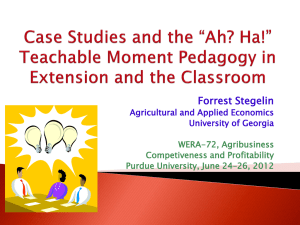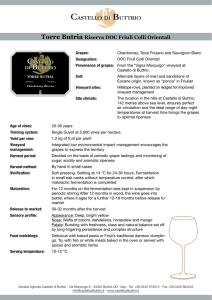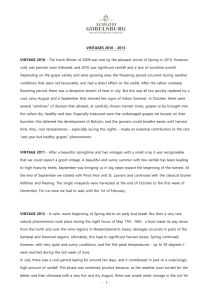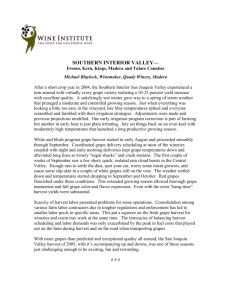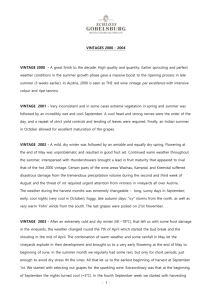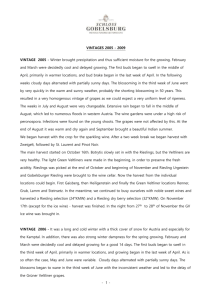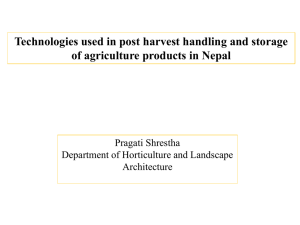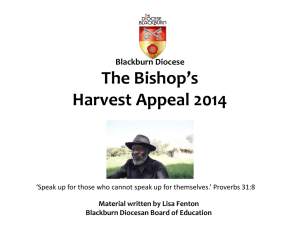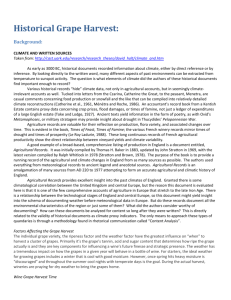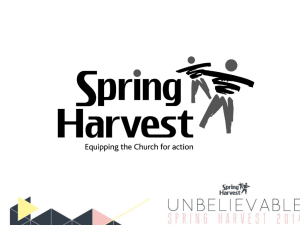Case Studies and the *Ah? Ha!* Teachable Moment
advertisement
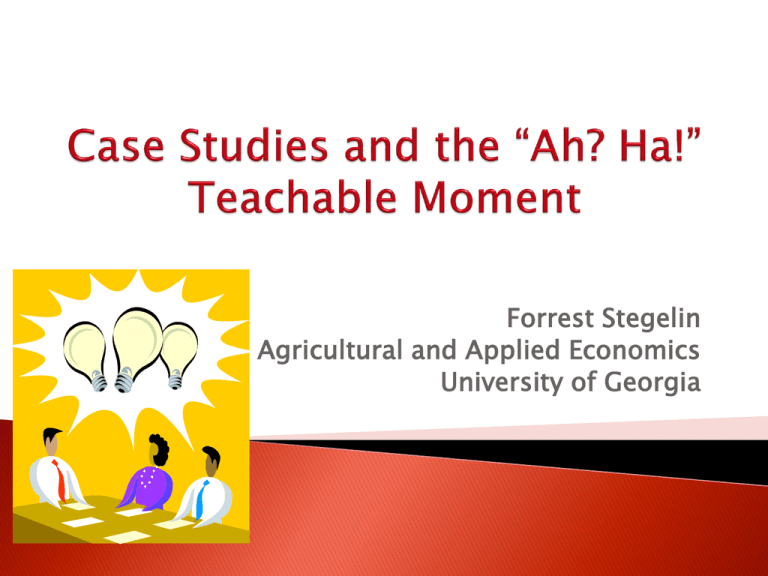
Forrest Stegelin Agricultural and Applied Economics University of Georgia Concrete Students require objects, events, or actions for logical reasoning. Formal Students can reason abstractly without reference to concrete objects, events, or actions. Conservation, class inclusion, Theoretical, propositional, ordering, and reversibility are hypothetical, and combinatorial characteristic reasoning patterns. reasoning patterns are characteristic. Students are unaware of inconsistencies and mistakes in reasoning. Students are aware of inconsistencies and mistakes due to the use of mental checks and balances – reflective thought. Students need clear, sequential directions for long and detailed projects. Students can establish their own plans for long and detailed projects if given aims and goals. Recognize the role(s) a case may play in developing interaction among students and instructor; Define and articulate the characteristics of a strong case; Apply the seven-step approach in analyzing a case plus writing a case report; Communicate the teachable moments and learning benefits expected from completing a case analysis. Case studies have proven to be effective pedagogical tools for undergraduate, graduate, and continuing or public service education audiences in the curriculum areas that require problem-solving and decisionmaking skills, statistical analysis, and management sciences. Applicable for a course that is decision- and actionoriented, integrated in both form and pedagogy within a curriculum, and managerially exciting. Methodologies of decision and risk analysis, probability and statistics, competitive analysis, and management science are integrated with personal judgment, intuition, and common sense in a way that is meaningful to student and executive learners alike. In the case method as a teaching strategy transfers responsibility for learning from teacher to student, whose role shifts from passive absorption toward active construction. Through careful examination and discussion, students learn to identify actual problems and to articulate them so as to become aware of those aspects of a situation that contribute to the problem. Along the way students develop the power to analyze and to master a tangled circumstance by identifying and delineating important factors – the ability to utilize ideas, to test them against facts, and to throw them into fresh combinations. A variety of roles in a course – ◦ ◦ ◦ ◦ focused on understanding core tools and concepts, on applying methodology appropriately, on defining the limits of good practice, on inventing new methods and adapting existing ones for the problem at hand. Forms of cases – ◦ highly structured, focusing on a single issue, with needed data laid out; ◦ appraisal cases where analysis is partly or wholly done; ◦ unstructured, with multiple issues and data challenges (missing or incomplete data, choices among data, or data preparation needed). Types of case study – ◦ illustrative case studies (primarily descriptive), ◦ exploratory case studies (pilot or condensed studies performed before implementing a large scale investigation), ◦ cumulative case studies (serving to aggregate information), and ◦ critical instance case studies (examining a situation of unique interest – answering cause and effect questions). Relevancy is key, that the resolution of the situation matters. Issues of external validity, construct validity, and reliability need to also be carefully considered. A strong case demonstrates a need to know something not currently known – involves practice of skills and requires some internalization of concepts and the articulation of the reasoning process. Case study approach is a comparatively flexible method of scientific research because it emphasizes exploration rather than prescription or prediction. Case study approach gives research results a more human face. Inherent subjectivity whereby the approach relies on personal interpretation of data and inferences; High investment in time and thinking; and Ethical considerations, namely the personal integrity, sensitivity, and possible prejudices and/or biases of the investigators need to be taken into consideration. 1. 2. 3. 4. 5. 6. 7. Read the case thoroughly; Define the central issue; Define the firm’s goals; Identify the constraints of the problem; Identify all the relevant alternatives; Select the best alternative; and Develop an implementation plan. Should we harvest our Riesling grapes immediately, before the forecast rainstorm, or leave them on the vines despite the approaching storm? For this case, take 5 – 10 minutes to read the onepage case and take any notes or underscore any facts thought to be relevant to the problem. Different wines with different prices arise if harvest immediately, wait to see if rains and does rain, wait to see if rains and doesn’t rain so wait for maturity of grapes. What should we do with the grapes (harvest or wait)? Revenue = Price x Quantity Which choice gives highest expected price? Harvest immediately: Wait and see: Wait and see: Harvest immediately: bottled wine (100%) - $2.85; bulk wine (100%) or bulk grapes (100%) - $1.00 equivalent bottle Wait and see: storm – botrytised (mold) (40%) - $8.00 or weak and thin (concentration) (60%) - $2.00 Wait and see: no storm (wait for maturity) – sugars >25% (35%) [$3.50]; sugars 20-25% (35%) [$3.00]; sugars <20% (10%) [$2.50] or acidity <0.7% (20%) [$2.50] Which choice gives highest expected average price? Consider the probabilities of each occurrence, with 100% total probabilities for each occurrence. Multiply the expected wholesale price per bottle times the percentages of occurrence to get weighted average expected price. Calculate the expected weighted average price per 750 ml bottle for immediate harvesting versus the probable outcomes of the 50 – 50 chance of rain. Harvest Now Wholesale Price 2.85 1.00 equiv. 1.00 equiv. Harvest Immediately Bottled (100%) Bulk Wine (100%) Bulk Grapes (100%) Botrytised (40%) 8.00 (30% ↓ yield) Weighted Price 2.85 1.00 equiv. 1.00 equiv. $2.85 1.60 Storm (50%) Wait & See Weak/Thin (60%) 2.00 100% wait & see; storms .60 >25% (35%) 20-25% (35%) <20% (10%) .61 .52 .12 Sugars No Storm (50%) (wait for maturity) Acidity 3.50 3.00 2.50 <0.7 (20%) 2.50 100% wait & see; maturity .25 $3.20
